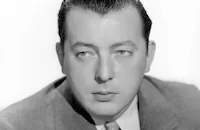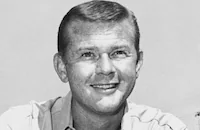Halls of Montezuma
Brief Synopsis
Cast & Crew
Lewis Milestone
Richard Widmark
Walter "jack" Palance
Reginald Gardiner
Robert Wagner
Karl Malden
Film Details
Technical Specs

Synopsis
During World War II, a Marine battalion prepares to land on a large Japanese-held island in the South Pacific. Lt. Col. Gilfillan warns the men that it will be a tough mission, and that they have been ordered to take prisoners in order to gain information about the Japanese fortifications. Below deck, Lt. Carl A. Anderson, a chemistry teacher in civilian life, questions his former student, Corp. Stuart Conroy, who complains that he is ill and cannot fight. Knowing that Conroy is just frightened and battle weary, Anderson assures him that he has shown courage before and can do so again. Anderson and Conroy then join the rest of the men, and during the journey in the landing boat, medic C. E. "Doc" Jones recalls an incident a few months earlier when Anderson revealed that he was suffering from "psychological migraines." Although Doc urged Anderson to seek treatment in the United States, Anderson refused to leave his men and has been relying on Doc to supply him with painkillers. The men hit the beach and successfully dig in, despite an initial burst of resistance. As four days pass, Anderson's squad, which includes boxer Pigeon Lane, Sgt. Zelenko, Pvt. Slattery, Coffman, Pvt. Whitney and the unstable Pretty Boy, grows weary of the constant moving and hidden Japanese snipers. One day, the men try to take a ridge of hills, but are beaten back by Japanese rockets, much to the surprise of the commanding officers, who were unaware that rockets were in the enemy's arsenal. Coffman is killed during the battle, and the furious Anderson is forced to take some of Doc's pills. At the Army's island headquarters, Anderson meets with other officers as Gilfillan recounts the troubles they are having capturing prisoners and getting information from them. Sgt. Randolph Johnson, an unconventional soldier who specializes in tricking Japanese prisoners into talking, questions one prisoner, who has been dubbed Willie. As Gilfillan receives orders to stop the rockets within nine hours, before the next assault on the hills, Willie informs Johnson that the Japanese soldiers holding a cave stronghold are willing to surrender. Accompanied by Johnson and war correspondent Sgt. Dickerman, Anderson leads a patrol to the cave, but upon their arrival, they are ambushed and Zelenko is blinded. The men capture the remaining Japanese, including an officer named Capt. Ishio Makino, soldiers Romeo and Nomura and a shell-shocked, elderly civilian. Anderson finds a map on one of the dead officers, then leads the men across a river and through the jungle. After a sniper shoots at him, Pretty Boy kills the man during hand-to-hand combat, but the confrontation further unbalances him and he attempts to murder the prisoners. Lane then accidentally shoots and kills Pretty Boy while attempting to hold him off. Later, the wounded Doc tries to tell Dickerman how inherently good Anderson is despite his bitterness. Doc gives Dickerman his notebook, in which he has written a message for Anderson, then dies. Anderson and the remaining men return to headquarters, where Makino commits hara-kiri with a knife he had stolen from Johnson. While map expert Lt. Butterfield works on a Japanese map overlay found by Pretty Boy, Anderson and Johnson learn that Nomura is actually an important leader named Maj. Kenji Matsuoda. Johnson finally deduces where the rockets are located, and a barrage begins as Anderson rejoins his men outside. As they prepare, Anderson learns that Conroy has been killed by a sniper. With only Lane, Whitney and Slattery left of his squad, Anderson takes the news hard and is ready to give up. Dickerman reads aloud Doc's note, however, and Anderson, inspired by Doc's appeal for him to be strong for the sake of those whom he survives, throws away his painkillers and leads his men into battle.

Director

Lewis Milestone
Cast

Richard Widmark

Walter "jack" Palance

Reginald Gardiner

Robert Wagner

Karl Malden
Richard Hylton

Richard Boone

Skip Homeier
Don Hicks

Jack Webb
Bert Freed

Neville Brand

Martin Milner
Philip Ahn
Howard Chuman
Frank Kumagi
Fred Coby
Paul Lees
Fred Dale
Chris Drake
George Conrad
Harry Mckim
William Hawes
Roger Mcgee
Helen Hatch
Michael Road
Rollin Moriyama
William T. Yokota
Ralph Nagai
Jerry H. Fujikawa
Frank Iwanaga
Charles Lee
Harris Matsushige
Ishizo Sano

Marion Marshall
Harry Carter
Richard Allan
Jack Lee
Pat Combs
Robert Board
Fred Shellac
John Close
Mike Capanna

Don Gordon
John Mckee
Al Negbo
Brad Slaven
George Offerman
Joe Turkel
Robert Bohannon
Bob Mclean
Clarke Stevens
Shirley Christensen
Trueman Oshima
Benito Marcus
Buster Hobbs
Mrs. Po
Juan Marcus
Marcus Silva
Crew
Robert Bassler
Serge Bertensson
Michael Blankfort
Henry Carey
Leonard Doss
Major George A. Gilliland U.s. Marine Corps
Winton C. Hoch
Albert Hogsett
Harry Jackson
Sol Kaplan
Charles Lemaire
Harry M. Leonard
Thomas Little
Bruce Macdonald
Lionel Newman
Ben Nye
Jacques Offenbach
Edward Powell
William Reynolds
Fred Sersen
John Phillip Sousa
Eiji E. Tanabe
E. Clayton Ward
Nate Watt
Lyle Wheeler

Film Details
Technical Specs

Quotes
Trivia
Notes
The opening credits of this film include the following written dedication: "To the United States Marine Corps-This story is dedicated in gratitude for its help in making it possible-But most of all for its stalwart defense of all we hold dear to our lives, our people, and our future." According to studio publicity, producer Robert Bassler and studio production head Darryl F. Zanuck found the "key" to the film's plot in a Marine short subject film entitled Objective-Prisoners, in which the importance of taking prisoners for intelligence purposes was demonstrated. Although the Twentieth Century-Fox Produced Scripts Collection, located at the UCLA Arts-Special Collections Library, contains treatments for the film written by Harry Kleiner, Sy Bartlett and technical advisor Maj. George Gilliland, their work was not used in the final film. According to the Twentieth Century-Fox Records of the Legal Department, also located at UCLA, Kleiner and Bartlett "wrote an 'original treatment'-based on 'nothing' in which to utilize actual combat film-which the Marines offered us-of the invasion of certain Islands."
The legal files also note that second-unit footage of Marine Corps manuevers, filmed on location at Camp Pendleton, near Oceanside, CA, was shot between 1 May and May 12, 1950. Studio publicity announced that shortly after the scenes of their manuevers were shot, the Marine and Naval units involved were sent into combat in Korea. According to a January 27, 1949 Los Angeles Times news item, Dana Andrews, Anne Baxter and Paul Douglas were originally set to star in the picture. Halls of Montezuma marked the screen debut of actor Richard Boone. Although studio publicity claimed that the picture also marked the debut of Robert Wagner, he had previously appeared in the 1950 M-G-M production The Happy Years.
Hollywood Reporter news items noted that proceeds from the film's premieres in New York and Los Angeles benefitted Marine Corps charities, and that both premieres were attended by Marine officials and veterans. The studio worked closely with the Corps to use the film for recruitment, and an January 11, 1951 Hollywood Reporter news item noted that a full company of Marine recruits were to be sworn in at the film's San Francisco premiere.

Miscellaneous Notes
Released in United States January 1951
Released in United States Winter January 1, 1950
Released in USA on video.
Released in United States January 1951
Released in United States Winter January 1, 1950











